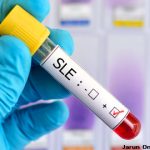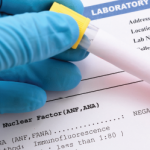Several theories exist for why common autoantibodies in healthy people are nonpathogenic. Some are produced by immature B cells that are not programmed for affinity maturation by antigen stimulation or somatic mutation. Another theory is that the autoantigen is not in a location accessible to antigen-processing cells and autoreactive B cells. One method of this immune system sequestration is that many autoantigens are intracellular. Healthy apoptosis prevents immune system exposure.
ANA IFA
The ACR recommends ordering ANA by IFA methodology using human epidermoid tumor cell-line #2 (HEp-2) cells. Part of the reason is that ANA by IFA identifies many more possible nuclear antigen targets than the cheaper and easier to perform solid-phase immunoassays, including the multiplex immunoassay and the enzyme-linked immunosorbent assay (ELISA).8
However, several studies have demonstrated wide variations in ANA IFA results, even between instruments used by the same manufacturer.9 ANA may be positive in one laboratory, yet negative in another. Due to this, there is a push for improved ANA IFA standards among commercial laboratories.
ANA IFA Titer
The IFA ANA test applies the person’s serum to HEp-2 cells on a slide. ANAs from the patient’s blood then bind to antigens in the HEp-2 cells. The technician adds fluorescent-tagged immunoglobulins that bind to the antibodies.
Under the microscope, fluorescent-tagged ANAs appear as a yellowish-green glow. If ANAs are present, dilution tests are performed. When the technician adds an equal part of the diluting solution to the serum, the result is a 1:1 mix (or titer). When the lab technician adds a second equal amount of diluting solution, the result is a 1:2 titer and so on. This is repeated until the serum no longer fluoresces. The last titer that fluoresced is noted. Higher ANA concentrations result in higher titers.
ANA results are reported with the pattern noted by the technician as well as the titer. The titer result is the most helpful clinically. Most labs consider a titer of 1:40 or 1:80 and higher to be a positive ANA.
The greater the titer, the greater the likelihood for a systemic autoimmune rheumatic disease (SARD). An ANA of 1:80 has a positive predictive value of only 2% for a SARD, but it is around 50% with an ANA of 1:640 or higher.9
The likelihood, or post-test probability, that someone with a positive ANA has a SARD depends on the pre-test probability and the likelihood ratio of the ANA result. In clinical practice, we rarely calculate actual numbers. However, it is important to at least note subjective approximations.

